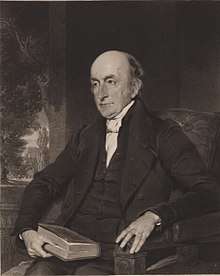William Field (minister)
William Field (6 January 1768 – 16 August 1851) was an English Unitarian minister.

Early life
Field was born at Stoke Newington on 6 January 1768. John Field, his father, a London medical practitioner, and founder of the London Annuity Society, was a man of property, who married Anne, daughter of Thomas Cromwell, a grocer, and sister of Oliver Cromwell. Field got a good classical training; while at school he corresponded with his father in Latin. He studied for the ministry first at Homerton, but left that institution for doctrinal reasons soon after the appointment of John Fell. In 1788 he entered Daventry Academy under Thomas Belsham, and left when Belsham resigned (June 1789).
Religious career
Field succeeded James Kettle in 1789 as minister of the presbyterian congregation at Warwick, Warwickshire, where he was ordained on 12 July 1790. On this occasion Belsham gave the charge, and Joseph Priestley preached. Dr. Samuel Parr, who then first met Priestley, attended the service and the ordination dinner. Thus began Field's close intimacy with Parr, a connection fostered by their common devotion to classical studies. Field at once (1791) started a Sunday school (the first in Warwick). This led him into a squabble with some local clergy. Field, who was always ready for a pamphlet war, issued the first of many productions of his incisive pen, in which the dignity of style, and the profusion of literary and classical illustration, contrast curiously with the pettiness of the disputes. His meeting-house, rebuilt 1780, was fitted with a sloping floor, to improve its quality as an auditorium; Field excited some comment by surmounting the front of the building with a stone cross. About 1830 he undertook the charge of an old Presbyterian meeting-house at Kenilworth, conducting afternoon service in addition to his Warwick duties. This meeting-house was rebuilt (1846) by his son Edwin Wilkins Field. Field remained in active duty for nearly sixty years. He resigned Warwick in 1843, and was succeeded in 1844 by Henry Ashton Meeson, M.D. At Kenilworth he was succeeded in 1850 by John Gordon.
Teaching career
Field kept a boarding-school for many years at Leam, near Warwick. This led to his publishing some educational manuals, of which the most valuable was his Questions on the Gospel History, recommended in the Critical Review (June 1794) to theological students in the two universities. His history of Warwick and his life of Parr are important works.
Death and family
He died at Leam on 16 August 1851; a marble slab to his memory was placed in High Street Chapel, Warwick.
By his wife, Mary (Wilkins), who died at Liverpool on 2 October 1848, aged 64, he had a numerous family. Edwin Wilkins, the eldest, married Mary Sharpe, sister of the geologist Daniel and the banker and Egyptologist Samuel and niece of Samuel Rogers the man of letters; Horace was an architect.
Field was of diminutive stature, with a noble head; his portrait has been engraved. He never forgot the distinction of his Cromwell blood; his extensive correspondence was both erudite and racy; he was a genial host, and his conversation, in spite of his constitutional deafness, was very enjoyable.
Publications
Field published a multitude of pamphlets and sermons,
- "Letter to the Inhabitants of Warwick," &c., 1791, 8vo,
- "Letter to the Inhabitants … of Kenilworth," &c., 1848, 12mo.
In addition to these his chief publications were:
- A Series of Questions … as a Guide to the Critical Study of the Four Gospels, &c., 1794, 12mo; second edition, printed 1805;
- Copies were issued from time to time for private use (with various title-pages), but it was not published till 1846, 12mo, with large introduction
- An Historical and Descriptive Account of … Warwick and … Leamington, &c., Warwick, 1815, 8vo (anon., "advertisement" signed W. F.; plates).
- Memoirs of the Rev. Samuel Parr, LL.D., 1828, 2 vols. 8vo.
Field was a frequent contributor of critical and other articles to the Monthly Repository and Christian Reformer.
References
![]()